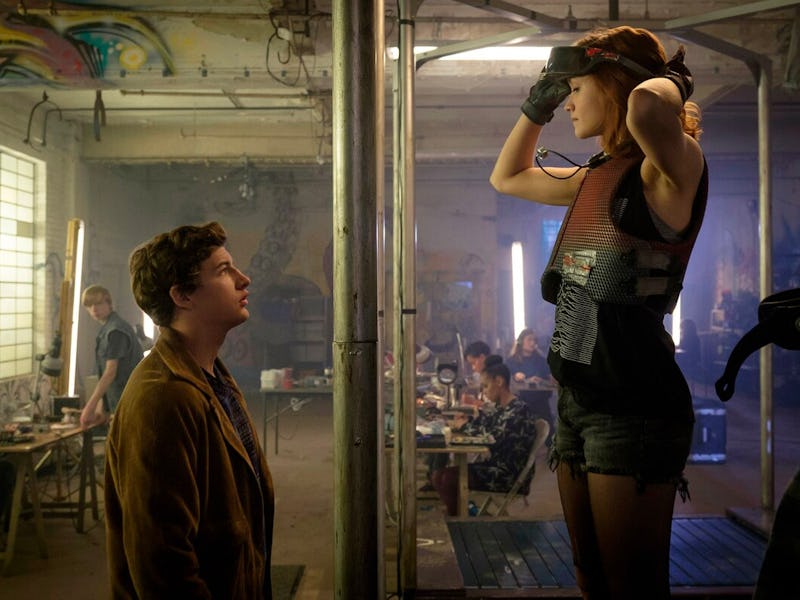Spielberg’s Most Underrated Sci-Fi Movie is a Dystopian Nightmare — But Tons of Fun to Watch
The future is haunting, but frequently stunning.

Ready Player One, it’s been said, is a horror movie disguised as an uncanny nostalgia trip. The year is 2045, and a revolving door of conflict and recession has forced humanity into the bosom of virtual reality. Many people now live fulfilling lives on an interface called the OASIS; like everything the Metaverse hopes to be, the OASIS is a haven for the chronically online.
You can create your own sexy avatar, or slip into the body of your favorite character (all the better if they’re owned by Warner Bros., who produced the film and populated it with its extensive catalog). You can enter the worlds of your favorite intellectual property — duke it out with King Kong, try to survive The Shining, or ride your version of the bike from Akira. Nothing is impossible; nothing is off-limits.
But nothing is real either. In the world of Ready Player One, there are no new ideas — not for the heroes who worship ‘70s and ‘80s pop culture, and certainly not for the villains who want to capitalize on the ludicrous, free-for-all tech. It’s all one big empty gesture to childhood wonder, a never-ending graveyard of genre references and winking nods. That was something of a bummer when the film premiered half a decade ago. It’s even more depressing now, as studios and streamers become increasingly greedy for IP, but less interested in what makes these stories work to begin with.
Despite that cultural dread, and all its other narrative issues, Ready Player One is not without charm. It helps that it had Steven Spielberg behind the camera, bringing his crowd-pleasing bombast to the world originally conceived by author Ernest Cline. He directed a screenplay co-penned by Cline, which might be what keeps the film from the self-awareness that would turn it into a dystopian horror. Is their unique brand of whimsy — reinforced by Alan Silvestri’s sweeping score — completely disconnected from the true premise of Ready Player One? Definitely. But it’s hard to knock the film for the total joyride it can otherwise be.
Ready Player One is essentially Charlie and the Chocolate Factory with a tech-y twist. Wade Watts (Tye Sheridan) is just one of many iPad babies with an emotional tether to the OASIS, and like just about half the world’s population, he’s embarrassingly obsessed with the creators of the universe, James Halliday (Mark Rylance) and Ogden Morrow (Simon Pegg). He especially worships Halliday, having consumed every morsel of media the late tech god enjoyed, and even committing entire swaths of Halliday’s life to memory. Ready Player One does not frame this obsession as unhealthy, but as a necessary, even academic, pursuit.
The OASIS is part playground, part living archive. Halliday cataloged every moment of his life, every film he ever saw, and every song he ever heard for players to enjoy for themselves. He also hid an Easter egg hunt within the OASIS, one that can only be won with an intimate knowledge of Halliday’s experiences and tastes.
Ready Player One’s avatars are rendered with such breathtaking effect, you almost forget how uncanny this whole universe is.
Whoever’s lucky enough to survive a trio of impossible challenges and retrieve three hidden keys will become Halliday’s successor. They’ll also inherit the trillion-dollar fortune he left behind, and as almost every player is only rich in the OASIS, that’s an opportunity few are willing to pass up.
Ready Player One kicks off five years into the hunt for Halliday’s treasure, when Wade finally finds the first key. With the help of his online friends, and manic pixie e-girl Art3mis (Olivia Cooke), he tries to complete Halliday’s quest, but competition is stiff, especially with the CEO of Innovative Online Industries (a great Ben Mendelsohn) doing everything he can to swoop in and seize control. But Wade, fortunately, is pure of heart and hates corporate greed about as much as he loves the OASIS. He is obviously Halliday’s ideal successor, so once he gets started it takes him little time to race through the challenges.
Wade’s adventure through the OASIS is frequently cringe-inducing; not one scene goes by without a passing reference (or 10) to pop culture history. Our heroes are nerds, and a great many of them are insufferable about it. In real life, this would be an unmitigated nightmare: imagine if our world suddenly revolved around a figure as beloved as Stan Lee. Deep cuts about their life and work would become the only relevant currency, while toxic fandom would gain a new sense of entitlement. In fact, it feels like society has been moving in that direction, making Ready Player One just a little less speculative with every year that passes.
Ready Player One shows us that dystopia can have its perks.
Spielberg, for what it’s worth, does encourage his audience to touch grass whenever possible. Player One’s final, messy act is a half-baked treatise on the merits of the real world versus the fake, as its heroes gradually meet up without hiding behind their avatars and power-ups. The “real” world of the film is genuinely in shambles, however, and there’s a sense that Spielberg would rather spend time building out the OASIS.
That attention to detail pays off. Yes, the universe is packed with too many Easter eggs to count, but they all look amazing, and overwhelm the senses in a way that makes Ready Player One the perfect “turn your brain off” epic. There may come a day when the whole thing feels irrevocably soulless, but for now, there’s nothing much to do except watch and enjoy.
Ready Player One is streaming on Netflix.
This article was originally published on